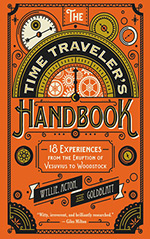
![]() Deven Science
Deven Science
6/30/2016
![]()
The Time Traveler's Handbook (Harper Design 2016), researched and written by James Wyllie, Johnny Acton, and David Goldblatt, bills itself as a guide book for a tourism company that sends people back in time to any of 18 different moments in history, so that one may witness the moment for themselves. Why travel to see the ruins of Pompeii, when you can travel to 79 AD in order to watch the very event that has made that city famous in history?
The concept is a good one, but when I started the novel, which begins with a historic meeting of King Henry VIII of England and King Francis I of France, I soon learned the true purpose of the book. The three authors have taken 18 moments in time, meticulously researched them to near infinite detail, and presented them here, in the guise of fiction. At first, I was almost insulted. Why not just write this as a history book, and show us these wonderfully crafted and well-researched moments? Why use time travel as a kid's spoon shaped like an airplane, making landing noises as you have us eat carrots by pretending our mouths are the hanger? The descriptions of the tent cities and ceremonies of the two kings was very well done, but I was annoyed that the authors thought I needed this device, even as I realized that I did indeed only pick up the book because of the time travel angle.
And then the next chapter came, the 1904 St. Louis World's Fair, and I was hooked. I grudgingly admitted that I needed to occasionally be spoon fed things like this, and I ate it up! The description of the World's Fair really captured me. One of the most fascinating to me was the Boer War Exhibit, which had 600 actors to reenact battles from the Anglo-South African War, many of whom were veterans of that war from both sides! Anthropological areas like the Philippines Village, which had the U.S. Department of War assemble 1,200 Filipinos to mimic their everyday life in a sort of reservation. Replicas of sections of several foreign cities or monuments, such as the Wailing Wall, or the Dome of the Rock, with each one populated by real Muslims, Jews, etc. The exhibits and displays went on and on, all incredible in different ways. Imagine how an exhibit featuring a working slaughterhouse would go over now, as children file through to watch animals killed and butchered. I found myself marveling at what the sheer size of the fair must have been, and how I'd never seen anything quite like it in my lifetime.
From then on, they had me, and I thoroughly enjoyed the book. Some chapters were naturally more interesting than others, more a sign of being parallel with my interests, and not a reflection that the other sections were in any way weak or inferior. I found myself not as involved with Opening Night at Shakespeare's Globe, and then they would have me eating up every written detail the next chapter for the Golden Age of Hollywood.
One small issue with the entire concept is that since it is billed as a tour guide of sorts, there is no narrative. The book merely ends, with no sort of wrap up, conclusion, or summary. There is no hero to celebrate, no enemy to see vanquished. It finishes its description of your journey to see the First Battle of Bull Run in 1861, and then it ends. That's fine really, it had no plot to wrap up. It just felt a bit... abrupt.
Still, it is an incredibly thorough book, with plenty of details to immerse in the selected time periods, always being sure to address clothes, food and drink, methods of travel, lingo or slang of the time, and then throwing in things like where and when you will arrive and depart to these locations. They helpfully include dos and don'ts at each step, so as to give you the best bang for your buck (and also, so as to avoid accidentally altering the past).
I highly recommend the book.
http://deven-science.livejournal.com/